Metaphase to anaphase (mat) transition-defective mutants in Caenorhabditis elegans
- PMID: 11134076
- PMCID: PMC2150685
- DOI: 10.1083/jcb.151.7.1469
Metaphase to anaphase (mat) transition-defective mutants in Caenorhabditis elegans
Abstract
The metaphase to anaphase transition is a critical stage of the eukaryotic cell cycle, and, thus, it is highly regulated. Errors during this transition can lead to chromosome segregation defects and death of the organism. In genetic screens for temperature-sensitive maternal effect embryonic lethal (Mel) mutants, we have identified 32 mutants in the nematode Caenorhabditis elegans in which fertilized embryos arrest as one-cell embryos. In these mutant embryos, the oocyte chromosomes arrest in metaphase of meiosis I without transitioning to anaphase or producing polar bodies. An additional block in M phase exit is evidenced by the failure to form pronuclei and the persistence of phosphohistone H3 and MPM-2 antibody staining. Spermatocyte meiosis is also perturbed; primary spermatocytes arrest in metaphase of meiosis I and fail to produce secondary spermatocytes. Analogous mitotic defects cause M phase delays in mitotic germline proliferation. We have named this class of mutants "mat" for metaphase to anaphase transition defective. These mutants, representing six different complementation groups, all map near genes that encode subunits of the anaphase promoting complex or cyclosome, and, here, we show that one of the genes, emb-27, encodes the C. elegans CDC16 ortholog.
Figures
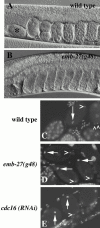

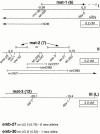
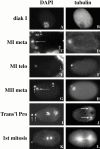
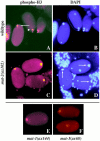

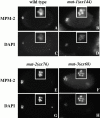


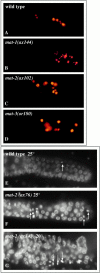
Similar articles
-
EMB-30: an APC4 homologue required for metaphase-to-anaphase transitions during meiosis and mitosis in Caenorhabditis elegans.Mol Biol Cell. 2000 Apr;11(4):1401-19. doi: 10.1091/mbc.11.4.1401. Mol Biol Cell. 2000. PMID: 10749938 Free PMC article.
-
The Cdc20 homolog, FZY-1, and its interacting protein, IFY-1, are required for proper chromosome segregation in Caenorhabditis elegans.Curr Biol. 2002 Dec 23;12(24):2118-23. doi: 10.1016/s0960-9822(02)01392-1. Curr Biol. 2002. PMID: 12498686
-
Developmental defects observed in hypomorphic anaphase-promoting complex mutants are linked to cell cycle abnormalities.Development. 2003 Apr;130(8):1605-20. doi: 10.1242/dev.00385. Development. 2003. PMID: 12620985 Free PMC article.
-
Control of metaphase-anaphase progression by proteolysis: cyclosome function regulated by the protein kinase A pathway, ubiquitination and localization.Philos Trans R Soc Lond B Biol Sci. 1999 Sep 29;354(1389):1559-69; discussion 1569-70. doi: 10.1098/rstb.1999.0499. Philos Trans R Soc Lond B Biol Sci. 1999. PMID: 10582241 Free PMC article. Review.
-
Separating sister chromatids.Trends Biochem Sci. 1999 Mar;24(3):98-104. doi: 10.1016/s0968-0004(99)01358-4. Trends Biochem Sci. 1999. PMID: 10203756 Review.
Cited by
-
Maternal MEMI Promotes Female Meiosis II in Response to Fertilization in Caenorhabditis elegans.Genetics. 2016 Dec;204(4):1461-1477. doi: 10.1534/genetics.116.192997. Epub 2016 Oct 11. Genetics. 2016. PMID: 27729423 Free PMC article.
-
Phospho-regulation pathways during egg activation in Drosophila melanogaster.Genetics. 2013 Sep;195(1):171-80. doi: 10.1534/genetics.113.150110. Epub 2013 Jun 21. Genetics. 2013. PMID: 23792954 Free PMC article.
-
Developmental Control of the Cell Cycle: Insights from Caenorhabditis elegans.Genetics. 2019 Mar;211(3):797-829. doi: 10.1534/genetics.118.301643. Genetics. 2019. PMID: 30846544 Free PMC article. Review.
-
APC/CFZR-1 Controls SAS-5 Levels To Regulate Centrosome Duplication in Caenorhabditis elegans.G3 (Bethesda). 2017 Dec 4;7(12):3937-3946. doi: 10.1534/g3.117.300260. G3 (Bethesda). 2017. PMID: 29030390 Free PMC article.
-
Identification of Conserved MEL-28/ELYS Domains with Essential Roles in Nuclear Assembly and Chromosome Segregation.PLoS Genet. 2016 Jun 24;12(6):e1006131. doi: 10.1371/journal.pgen.1006131. eCollection 2016 Jun. PLoS Genet. 2016. PMID: 27341616 Free PMC article.
References
-
- Albertson D.G. Formation of the first cleavage spindle in nematode embryos. Dev. Biol. 1984;101:61–72. - PubMed
-
- Albertson D.G., Thomson J.N. Segregation of holocentric chromosomes at meiosis in the nematode, Caenorhabditis elegans . Chromosome Res. 1993;1:15–26. - PubMed
-
- Altschul S.F., Gish W., Miller W., Myers E.W., Lipman D.J. Basic local alignment search tool. J. Mol. Biol. 1990;215:403–410. - PubMed
-
- Beanan M.J., Strome S. Characterization of a germ-line proliferation mutation in C. elegans . Development. 1992;116:755–766. - PubMed
-
- Blatch G.L., Lassle M. The tetratricopeptide repeata structural motif mediating protein-protein interactions. Bioessays. 1999;21:932–939. - PubMed
Publication types
MeSH terms
Substances
Grants and funding
LinkOut - more resources
Full Text Sources
Molecular Biology Databases

